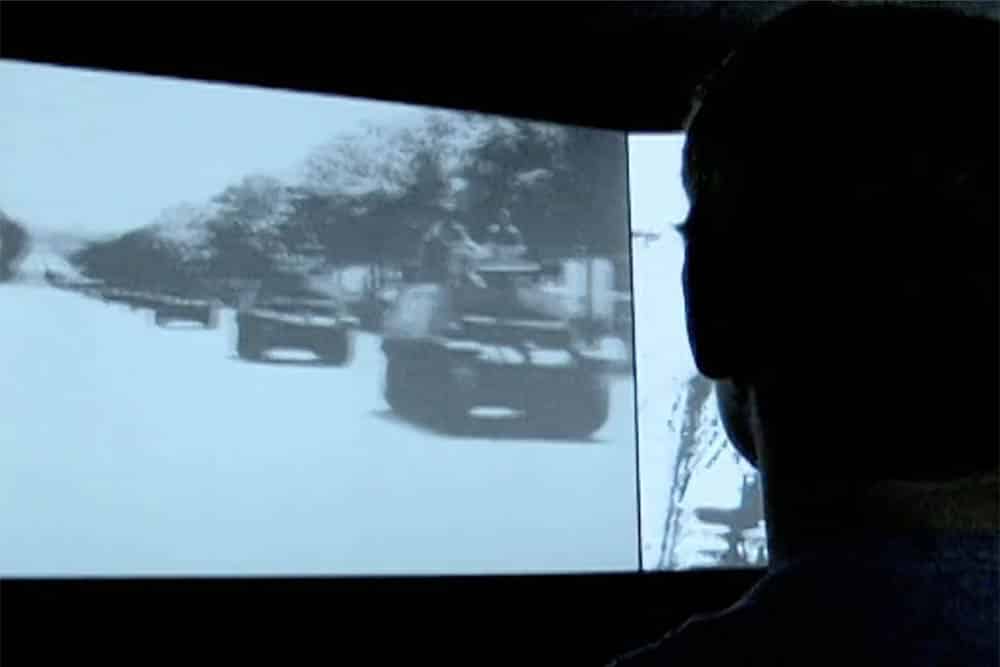
“I’m a re-interpreter,” says Rabbi Dorothy Richman of Berkeley Hillel. “Judaism has always, always changed and grown in each civilization it has met. And I see no reason why our present moment is different.” As she dons a prayer shawl, the rabbi appears to embody both ideas, the “always” of Judaism as well as the “change,” the past and the “present moment.” For her, she goes on, “Belief isn’t the point. Relationship, connection, dialogue, and commitment is the point.”
This dynamic notion is central to Between Two Worlds, which takes up a difficult question, that is, “Who gets to decide what Jewish and being Jewish is?” The question came to filmmakers Deborah Kaufman and Alan Snitow in 2009, when the San Francisco Jewish Film Festival occasioned not the usual “conversation” but instead deep division and anger. Kaufman provides brief background, noting that when she started the Festival in 1981, it was “fun and full of passionate debate.” But with the screening of the documentary Rachel – about an American activist who was killed by a bulldozer as she protested Israel’s demolition of Palestinian homes – activists called both the film and the choice to schedule it anti-Semitic.
Between Two Worlds shows efforts by the Festival’s executive director Peter Stein to turn this response into something like “passionate debate” (the Festival’s slogan has been “Let’s Talk”), even as he was facing a “firestorm”. Here Between Two Worlds highlights emails on a computer screen, messages comparing him to Hitler and calling the Festival “symptomatic of a demonic strategy”.
Similarly, Daniel Sokatch (then of the San Francisco Jewish Community Federation, which funds various organizations, without influencing events and programs) received threats. The camera follows Sokatch into his office, the wall behind him adorned with Robbie Conal’s Watching, Waiting, Dreaming, as he describes the “Jewish community”. “There is no sole arbiter, there is no Pope in the Jewish community,” he says. “What is alien to Jewish community is – I’ll call it almost a neo-McCarthyism – where one group says that it is the determiner of what is appropriate for community debate.”
As community members argue over what can be debated, Snitow and Kaufman look back at their own familial histories, as these reveal something like the “two worlds” of their title. Snitow’s mother, it turns out, was once a Communist, and Kaufman’s father a “passionate Zionist”. As these filmmakers find in these seemingly opposite positions very similar hopes for the “community”, they also see in their parents an openness to generational change, a willingness to embrace difference as part of their commitments to a tribe whose boundaries and values are in constant movement.
But as their parents provide particular models of Judaism (in their ways, much like the model described by Rabbi Richman), they find – and indict – another model that is less interested in change and more dedicated to “teaching lessons in the Holocaust”. As Rabbi Marvin Hier, of the Simon Weisenthal Center (SWC) Museum of Tolerance, puts it, “History has taught us you can’t take a chance on an idea that we are only a religion.” To reinforce that lesson, as of 2005, the SWC is building a Museum of Tolerance and Human Dignity on part of the Mamilla Cemetery, Jerusalem’s 800-year-old Muslim cemetery (Frank Gehry designed it but withdrew from the project in 2010).
Even as it appears to offer opposing views, Between Two Worlds plainly questions the possible “tolerance” demonstrated in such a project. Israel-Palestine Center for Research and Information founder Gershon Baskin points out that workers on the Jerusalem site are “digging up bones and putting them in boxes”, even as the project remember the Holocaust. “Holocaust memory,” Baskin argues, “has been very political, and we invoke Holocaust memory to justify almost anything that we’re doing.”
Rabbi Irwin Kula of the National Jewish Center for Learning and Leadership extends this idea, arguing that when Holocaust supplanted Exodus as “the orienting myth”, a kind of pathology was established. Echoing Hier’s own assertion (though Hier uses it to “justify” the SWC project), Kula says, “The most dangerous thing about Holocaust, the most dangerous thing about being abused, is that what you’re going to do is abuse others.” That abuse defines the community as such: Because of that you’re going to go small, you’re going to go tribal, you’re going to go insular, and you’re going to look at everybody, no matter what, through the prism that ‘they are my enemy.'”
The difference between Hier and Kula seems to be a difference between two worlds, so separate and intractable as to seem irreconcilable. Between Two Worlds tracks other instances of this difference, including last year’s debate over divestment at Berkeley. And yet, for all the argument and anger, Between Two Worlds submits – with a coda pointing to last year’s festival’s return to “conversation” – Jewish communities, like Gandhi, the Dalai Lama, and Martin Luther King, Jr., are still watching, waiting, and dreaming.
Between Two Worlds: trailer


![Call for Papers: All Things Reconsidered [MUSIC] May-August 2024](https://www.popmatters.com/wp-content/uploads/2024/04/all-things-reconsidered-call-music-may-2024-720x380.jpg)



